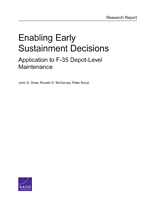| 来源类型 | Research Reports
|
| 规范类型 | 报告
|
| ISBN | 9780833081650
|
| 来源ID | RR-397-AF
|
| Enabling Early Sustainment Decisions: Application to F-35 Depot-Level Maintenance |
| John G. Drew; Ronald G. McGarvey; Peter Buryk
|
| 发表日期 | 2013
|
| 出版年 | 2013
|
| 页码 | 44
|
| 语种 | 英语
|
| 结论 |
Decisions About U.S. Air Force Weapon System Sustainment Often Do Not Consider the Effects on the Broader Sustainment Enterprise- Decisions about whether to use organic or contractor support for the long-term sustainment of a weapon system are often made within narrow organizational boundaries and do not consider the full range of capabilities in the enterprise to identify a more cost-effective option.
- A review of legacy program data also showed that this decisionmaking can be data-intensive and often occurs in isolation and late in a weapon system's acquisition process.
- History suggests that new aircraft systems generally act similarly to legacy aircraft systems at the technology/subsystem level. For this reason, the Air Force would benefit most from common sustainment strategies at this level as it moves forward with new acquisition programs.
The Air Force Would Benefit from a Framework to Support These Types of Decisions- U.S. Department of Defense guidance states that above-core depot workloads (those that the government has the option to outsource) should be assigned on the basis of a best-value determination, but this guidance does not specify how to determine "best value."
- A RAND-developed economic-based framework addresses this gap by helping planners determine the "best value" when assigning above-core sustainment workloads, but such an analytic tool would have longer-term benefits for the Air Force. For example, it can help planners compare and discover commonalities across subsystems, identify the effects of new or emerging technology on Air Force sustainment strategies, and contribute to the Air Force's mission to shape its sustainment enterprise.
|
| 摘要 |
- The Air Force should develop an enterprise sustainment strategy at the product support group or technology subsystem level and ensure that the appropriate sustainment infrastructure is in place.
- From there, it should adopt a set of criteria for support system design sourcing decisions that weapon system program offices can apply early in the acquisition process. Such criteria would help determine whether the enterprise has the capability to sustain the system and, if not, whether it would be beneficial to develop the capability.
- The RAND-developed framework offers the Air Force a helpful approach to start thinking more strategically about sustainment posture planning and illuminates the advantages of an enterprise-wide view of sustainment management. The Air Force should adopt the framework as it makes decisions regarding new acquisition programs, such as the F-35 Joint Strike Fighter, and as it addresses new technology developments affecting existing programs.
|
| 主题 | Aviation Maintenance
; Fighter Aircraft
; Military Acquisition and Procurement
; Military Facilities
; United States Air Force
|
| URL | https://www.rand.org/pubs/research_reports/RR397.html
|
| 来源智库 | RAND Corporation (United States)
|
| 资源类型 | 智库出版物
|
| 条目标识符 | http://119.78.100.153/handle/2XGU8XDN/107519
|
推荐引用方式
GB/T 7714 |
John G. Drew,Ronald G. McGarvey,Peter Buryk. Enabling Early Sustainment Decisions: Application to F-35 Depot-Level Maintenance. 2013.
|
|
文件名:
|
1387544801123.gif
|
|
格式:
|
GIF
|

|
文件名:
|
RAND_RR397.pdf
|
|
格式:
|
Adobe PDF
|
除非特别说明,本系统中所有内容都受版权保护,并保留所有权利。